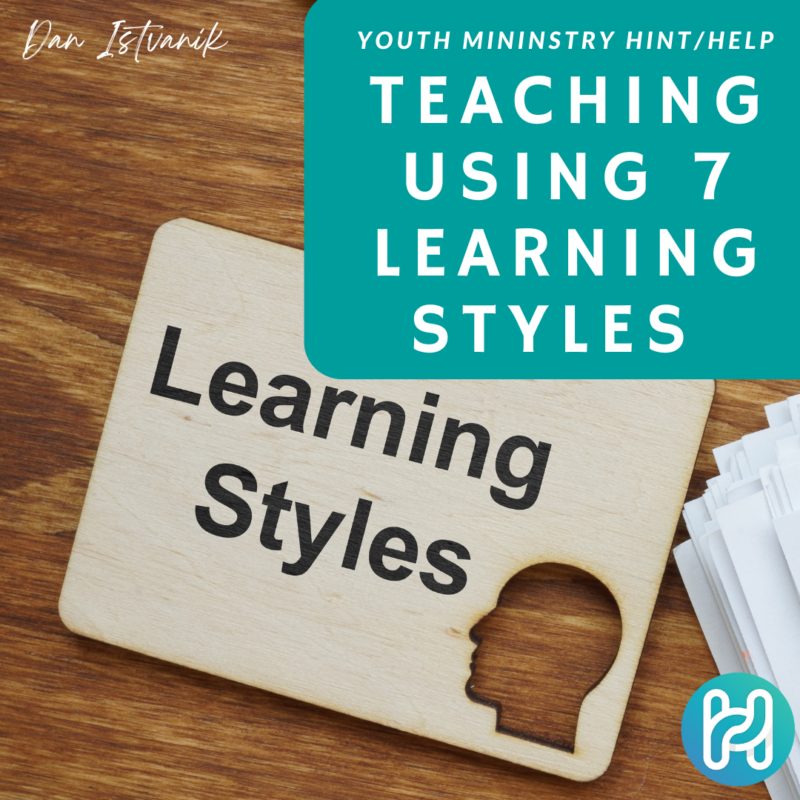Youth Ministry Lessons, Youth Ministry Thoughts
Teaching: Seven Learning Styles
Teaching Using the Seven Learning Styles in youth groups can be both rewarding and challenging, especially when considering the diverse learning styles present among the participants.
To effectively engage and educate students in your ministry, it’s crucial to employ a variety of teaching methods that cater to the 7 different learning styles of students. This comprehensive guide will explore how to utilize each learning style effectively in a youth group setting, ensuring an inclusive and engaging learning experience for all participants.
1. Visual Learners:
Visual learners learn best through visual aids and spatial understanding.
In a youth group setting, incorporating visual elements such as presentations, graphs/diagrams, and videos can greatly enhance their learning experience. Utilizing colorful media and mind maps can help organize information in a visually appealing way.
Additionally, encouraging visual learners to illustrate concepts and take visual notes can further reinforce their understanding of the material.
2.Auditory Learners:
Auditory learners thrive on listening and speaking activities.
Interactive lectures, group discussions, and debates can be highly beneficial for effectively engaging auditory learners in a youth group setting. Incorporating podcasts, audiobooks, and recorded lectures can provide additional auditory reinforcement.
Encouraging auditory learners to summarize information aloud and participate in oral presentations can further enhance their learning experience.
3. Verbal Learners:
Verbal learners excel in language-based activities such as reading, writing, and speaking.
Providing written materials such as handouts, textbooks, and articles can cater to their learning style. Encouraging verbal learners to write summaries, essays, and journal entries can help reinforce their understanding of the material.
Engaging them in debates, storytelling, and role-playing exercises can further develop their verbal skills and deepen their comprehension.
4. Physical/Kinesthetic Learners:
Physical or kinesthetic learners learn best through hands-on experiences and physical activities.
In a youth group setting, incorporating role-playing, simulations, and experiential learning activities can be highly effective. Using manipulatives, models, and props can help make abstract concepts tangible for kinesthetic learners.
Encouraging movement, gestures, and tactile exploration can further reinforce their understanding and retention of information.
5.Logical/Mathematical Learners:
Logical or mathematical learners excel in logical reasoning, problem-solving, and mathematical analysis.
Presenting information in a structured and systematic manner, emphasizing cause-and-effect relationships and logical sequences, can cater to their learning style. Incorporating logic puzzles, problem-solving activities, and critical thinking exercises can engage logical learners and stimulate their intellectual curiosity.
Encouraging them to analyze data, draw conclusions, and formulate hypotheses can further develop their logical thinking skills.
6. Social/Interpersonal Learners:
Social or interpersonal learners thrive in group settings and value interpersonal interaction.
Fostering collaboration, teamwork, and peer-to-peer learning opportunities is essential to effectively engage social learners in a youth group setting. Group discussions, cooperative learning activities, and collaborative projects can provide social learners with the interaction and support they need to succeed.
Encouraging them to work in teams, share ideas, and communicate effectively with their peers can further enhance their learning experience.
7. Solitary/Intrapersonal Learners:
Solitary or intrapersonal learners prefer to work independently and often excel in self-directed learning environments. I
in a youth group setting, providing opportunities for solitary reflection, self-paced learning, and individualized projects can cater to their learning style. Allowing solitary learners to set their own goals, pursue their interests, and explore topics in-depth can help them thrive academically and personally.
Encouraging self-assessment, goal-setting, and reflection can further empower solitary learners to take ownership of their learning journey.
By harnessing the power of the seven learning styles, youth pastors can create an inclusive and engaging learning environment for youth groups. By incorporating a variety of teaching methods that cater to visual, auditory, verbal, physical/kinesthetic, logical/mathematical, social/interpersonal, and solitary/intrapersonal learners, educators can ensure that all participants have the opportunity to learn and succeed. By embracing diversity and individuality, a youth pastor can inspire students to reach their full potential and become lifelong Biblical learners.
**TO SEE EXAMPLES OF THIS:
- Check out our resources: “7 Minute Sunday” and “One Nights”




